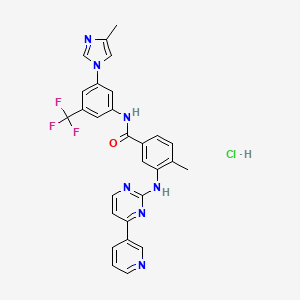
Nilotinib hydrochloride
Katalognummer B1258797
Molekulargewicht: 566.0 g/mol
InChI-Schlüssel: VTGGYCCJUPYZSX-UHFFFAOYSA-N
Achtung: Nur für Forschungszwecke. Nicht für den menschlichen oder tierärztlichen Gebrauch.
Patent
US08937082B2
Procedure details


To a 1 liter reactor was added Nilotinib-base (20 g, 0.04 mol), absolute ethanol (9.4 vol) and HCl solution (13.77% in ethanol abs., 10 g, 0.04 mol). The resulting slurry was heated to reflux, and dissolution occurred during the stirring. The solution was filtered under reduced pressure. The filtrate was fed back to the reactor and heated back to reflux temperature. At 76.6° C. the solution was seeded with 0.2 g of dry Nilotinib HCl form T17. A solid precipitate was formed, and the mixture was maintained at reflux for 1 hour. The mixture was then cooled over 2 h to 6° C. At 6° C., absolute ethanol (15 vol) was added and the resulting slurry was stirred at 5° C. for 30 minutes. The slurry was then filtered, and the separated solid was washed with absolute ethanol, and dried overnight at 70° C. in a vacuum oven to yield Nilotinib-HCl form T17 (18.4 g, 83% yield)



Identifiers


|
REACTION_CXSMILES
|
[CH3:1][C:2]1[CH:3]=[CH:4][C:5]([C:21]([NH:23][C:24]2[CH:25]=[C:26]([C:36]([F:39])([F:38])[F:37])[CH:27]=[C:28]([N:30]3[CH:34]=[N:33][C:32]([CH3:35])=[CH:31]3)[CH:29]=2)=[O:22])=[CH:6][C:7]=1[NH:8][C:9]1[N:10]=[CH:11][CH:12]=[C:13]([C:15]2[CH:16]=[CH:17][CH:18]=[N:19][CH:20]=2)[N:14]=1.[ClH:40]>C(O)C>[CH3:1][C:2]1[CH:3]=[CH:4][C:5]([C:21]([NH:23][C:24]2[CH:25]=[C:26]([C:36]([F:38])([F:39])[F:37])[CH:27]=[C:28]([N:30]3[CH:34]=[N:33][C:32]([CH3:35])=[CH:31]3)[CH:29]=2)=[O:22])=[CH:6][C:7]=1[NH:8][C:9]1[N:10]=[CH:11][CH:12]=[C:13]([C:15]2[CH:16]=[CH:17][CH:18]=[N:19][CH:20]=2)[N:14]=1.[ClH:40] |f:3.4|
|
Inputs


Step One
Step Two
|
Name
|
|
|
Quantity
|
0 (± 1) mol
|
|
Type
|
solvent
|
|
Smiles
|
C(C)O
|
Conditions


Temperature
|
Control Type
|
UNSPECIFIED
|
|
Setpoint
|
5 °C
|
Stirring
|
Type
|
CUSTOM
|
|
Details
|
the resulting slurry was stirred at 5° C. for 30 minutes
|
|
Rate
|
UNSPECIFIED
|
|
RPM
|
0
|
Other
|
Conditions are dynamic
|
1
|
|
Details
|
See reaction.notes.procedure_details.
|
Workups


TEMPERATURE
|
Type
|
TEMPERATURE
|
|
Details
|
The resulting slurry was heated
|
TEMPERATURE
|
Type
|
TEMPERATURE
|
|
Details
|
to reflux
|
DISSOLUTION
|
Type
|
DISSOLUTION
|
|
Details
|
dissolution
|
FILTRATION
|
Type
|
FILTRATION
|
|
Details
|
The solution was filtered under reduced pressure
|
TEMPERATURE
|
Type
|
TEMPERATURE
|
|
Details
|
heated back
|
TEMPERATURE
|
Type
|
TEMPERATURE
|
|
Details
|
to reflux temperature
|
CUSTOM
|
Type
|
CUSTOM
|
|
Details
|
At 76.6° C.
|
CUSTOM
|
Type
|
CUSTOM
|
|
Details
|
A solid precipitate was formed
|
TEMPERATURE
|
Type
|
TEMPERATURE
|
|
Details
|
the mixture was maintained
|
TEMPERATURE
|
Type
|
TEMPERATURE
|
|
Details
|
at reflux for 1 hour
|
|
Duration
|
1 h
|
TEMPERATURE
|
Type
|
TEMPERATURE
|
|
Details
|
The mixture was then cooled over 2 h to 6° C
|
FILTRATION
|
Type
|
FILTRATION
|
|
Details
|
The slurry was then filtered
|
WASH
|
Type
|
WASH
|
|
Details
|
the separated solid was washed with absolute ethanol
|
CUSTOM
|
Type
|
CUSTOM
|
|
Details
|
dried overnight at 70° C. in a vacuum oven
|
|
Duration
|
8 (± 8) h
|
Outcomes


Product
Details
Reaction Time |
30 min |
|
Name
|
|
|
Type
|
product
|
|
Smiles
|
CC=1C=CC(=CC1NC=2N=CC=C(N2)C=3C=CC=NC3)C(=O)NC=4C=C(C=C(C4)N5C=C(N=C5)C)C(F)(F)F.Cl
|
Measurements
| Type | Value | Analysis |
|---|---|---|
| YIELD: PERCENTYIELD | 83% |
Source


|
Source
|
Open Reaction Database (ORD) |
|
Description
|
The Open Reaction Database (ORD) is an open-access schema and infrastructure for structuring and sharing organic reaction data, including a centralized data repository. The ORD schema supports conventional and emerging technologies, from benchtop reactions to automated high-throughput experiments and flow chemistry. Our vision is that a consistent data representation and infrastructure to support data sharing will enable downstream applications that will greatly improve the state of the art with respect to computer-aided synthesis planning, reaction prediction, and other predictive chemistry tasks. |

